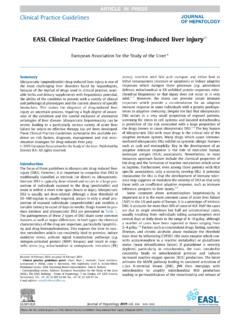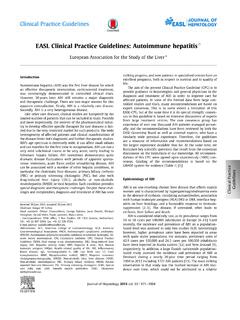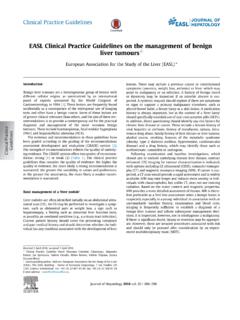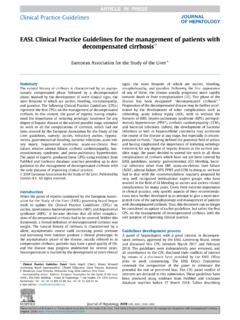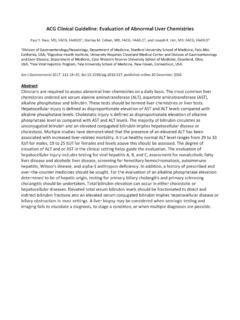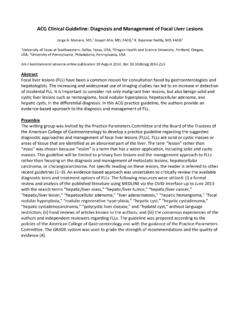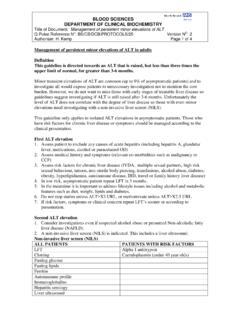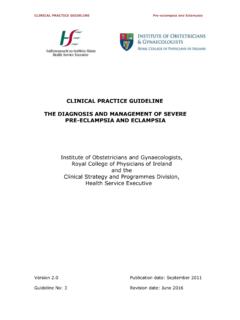Transcription of EASL Clinical Practical Guidelines on the management of ...
1 EASL Clinical Practical Guidelines on the managementof acute (fulminant) liver failureqEuropean Association for the Study of the liver SummaryThe term acute liver failure (ALF) is frequently applied as a gen-eric expression to describe patients presenting with or develop-ing an acute episode of liver dysfunction. In the context ofhepatological practice, however, ALF refers to a highly specificand rare syndrome, characterised by an acute abnormality of liverblood tests in an individual without underlying chronic liver dis-ease.
2 The disease process is associated with development of acoagulopathy of liver aetiology, and clinically apparent alteredlevel of consciousness due to hepatic encephalopathy. Severalimportant measures are immediately necessary when the patientpresents for medical attention. These, as well as additional clini-cal procedures will be the subject of these Clinical practiceguidelines. 2016 European Association for the Study of the liver . Publishedby Elsevier All rights term acute liver failure (ALF) is frequently applied as ageneric expression to describe patients presenting with ordeveloping an acute episode of liver dysfunction.
3 It is charac-terised by a deterioration in liver function tests, and poten-tially associated with dysfunction in other organs. ALF isfrequently, but often incorrectly used to describe both acutedeterioration in liver function in patients with chronic liverdisease (a condition that should be termed acute-on-chronicliver failure [AoCLF]), or liver involvement in systemic diseaseprocesses. liver injury secondary to alcohol, which presentsas alcoholic hepatitis, and other forms of AoCLF, can be dif-ficult to distinguish from ALF on occasion.
4 However, thereare clear differences, and different forms of managementare extensive liver resection, patients with or withoutunderlying chronic liver disease, may develop a clinicalsyndrome of jaundice, coagulopathy and hepatic encephalopa-thy (HE). The presentation is very similar to that of a post-transplant small for size syndrome scenario. These syndromesare not considered within the scope of ALF, but do feature insome ALF databases, such as the European liver TransplantRegistry (ELTR).
5 Extensive liver trauma is also included in ALFdatabases, but is not a cause of ALF unless there is loss of bothvenous and arterial the context of hepatological practice, ALF refers to ahighly specific and rare syndrome, characterised by an acuteabnormality of liver blood tests in an individual without under-lying chronic liver disease. The disease process is associatedwith development of a coagulopathy of liver aetiology, asopposed to the coagulation disturbance seen in sepsis, and clin-ically apparent altered level of consciousness due to HE.
6 Thecondition of patients who develop coagulopathy, but do nothave any alteration to their level of consciousness is definedas acute liver injury (ALI). Thus, the term ALF is appropriatelyused to describe patients who develop both coagulopathy andaltered mentation and will be the subject of these Clinical prac-tice features of coagulopathy, increased serum transaminases,abnormal bilirubin and altered levels of consciousness may beseen in patients with a variety of systemic disease , if there is no primary liver insult, these patients shouldbe considered to have a secondary liver injury and not ALF.
7 Man-agement should focus on the treatment of any underlying evidence and recommendations in these Guidelines havebeen graded according to the Grading of RecommendationsAssessment Development and Evaluation (GRADE) system[1].The strength of recommendations reflects the quality of theunderlying evidence. The GRADE system offers two grades of rec-ommendation: strong (1) or weak (2) (Table 1). The CPGs thusconsider the quality of evidence: the higher the quality of evi-dence, the more likely a strong recommendation is warranted;the greater the uncertainty, the more likely a weaker recommen-dation is and main Clinical features of ALFThe Clinical course of ALF is initiated with a severe ALI.
8 This ischaracterised by a two- to threetimes elevation of transaminases(as a marker of liver damage) associated with impaired liver func-tion, , jaundice and coagulopathy, in a patient without aJournal of Hepatology2017vol. 66j1047 1081 Received 7 December 2016; accepted 7 December 2016qClinical practice Guidelines panel:Chair: Julia Wendon; Panel members: JuanCordobay, Anil Dhawan, Fin Stolze Larsen, Michael Manns, Frederik Nevens, DidierSamuel, Kenneth J. Simpson, Ilan Yaron; EASL Governing Board representative:Mauro Bernardi Corresponding author.
9 Address: European Association for the Study of the liver (EASL), The EASL Building The Home of European Hepatology, 7 Rue Daubin,1203 Geneva, Switzerland. Tel.: +41 (0) 22 807 03 60; fax: +41 (0) 22 328 07 Cordoba passed away during the preparation of this Practice Guidelineschronic liver disease. This Clinical description originated fromobservations of drug related hepatotoxicity, but is applicable toall presentations[2].ALF was originally defined by Trey and Davidson in 1970 asfulminant liver failure, which was a potentially reversible condi-tion, the consequence of severe liver injury, with an onset ofencephalopathy within 8 weeks of the appearance of the firstsymptoms and in the absence of pre-existing liver disease [3].
10 In 1993, the syndrome was redefined to take into account theaetiology, frequency of complications and prognosis (Table 2)[4]. Considering jaundice as the first symptom, hyperacute liverfailure describes patients developing HE within 7 days of notingjaundice. Acute liver failure occurs when patients develop HEbetween 8 and 28 days of noting jaundice; and subacute liverfailure describes HE occurring within 5 12 weeks of jaundice(Fig. 1). Disease duration of greater than 28 weeks before theonset of encephalopathy is categorised as chronic liver International Association for the Study of the liver (IASL)sub-committee statement (1999) defined hyperacute ALF as lessthan 10 days, fulminant ALF as 10 days to 30 days and subacutehepatic failure as 5 to 24 weeks[7].



